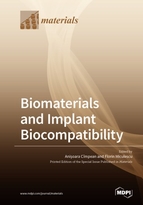Biomaterials and Implant Biocompatibility
A special issue of Materials (ISSN 1996-1944). This special issue belongs to the section "Biomaterials".
Deadline for manuscript submissions: closed (31 October 2019) | Viewed by 133581
Special Issue Editors
Interests: biomaterials and biocompatibility; tissue engineering; stem cells and regenerative medicine; cell biology; clinical biochemistry
Special Issues, Collections and Topics in MDPI journals
Interests: design and development of medical devices for bone reconstruction, synthesis, and preparation of calcium phosphates from natural sources; membrane materials; hybrid and composite materials
Special Issues, Collections and Topics in MDPI journals
Special Issue Information
Dear Colleagues,
The scientific advances in life sciences and engineering constantly challenge, expand and redefine the concepts related to biocompatibility and safety of medical devices. New biomaterials, new products and new testing regimes are introduced in the scientific research practices. In order to provide clinically predictive results and to ensure a high benefit-risk ratio for the patients we need to optimize the material and implant characteristics, and to adapt the performance and safety evaluation practices for these innovative medical devices.
Various characteristics related to materials and implant development such as raw materials composition, implants surface morphology, design, geometry, porosity and mechanical properties need to be thoroughly characterized before the evaluation of implants biological performance. Furthermore, with the increase of regulatory demands, biological evaluation needs to ensure appropriate models and methods for each implant development stage.
This Special Issue of Materials (ISSN 1996-1944) on "Biomaterials and Implant Biocompatibility” aims to focus on the recent progress in development, material testing, and biocompatibility and bioactivity evaluation of various materials including, but not limited to, bioceramics, biopolymers, biometals, composite materials, biomimetic materials, hybrid biomaterials and drug/device combinations for implants and prostheses with medical applications spanning from soft to hard tissue regeneration. Submitted manuscripts may cover all aspects, ranging from investigations into material characterization to in vitro and in vivo testing for the assessment of biological performance of advanced, novel biomaterials and implants.
We invite all colleagues to submit manuscripts (full papers, reviews or notes) in open access to this Special Issue. We encourage you to disseminate this invitation to any colleagues who may be interested.
Prof. Anişoara Cîmpean
Prof. Florin Miculescu
Guest Editors
Manuscript Submission Information
Manuscripts should be submitted online at www.mdpi.com by registering and logging in to this website. Once you are registered, click here to go to the submission form. Manuscripts can be submitted until the deadline. All submissions that pass pre-check are peer-reviewed. Accepted papers will be published continuously in the journal (as soon as accepted) and will be listed together on the special issue website. Research articles, review articles as well as short communications are invited. For planned papers, a title and short abstract (about 100 words) can be sent to the Editorial Office for announcement on this website.
Submitted manuscripts should not have been published previously, nor be under consideration for publication elsewhere (except conference proceedings papers). All manuscripts are thoroughly refereed through a single-blind peer-review process. A guide for authors and other relevant information for submission of manuscripts is available on the Instructions for Authors page. Materials is an international peer-reviewed open access semimonthly journal published by MDPI.
Please visit the Instructions for Authors page before submitting a manuscript. The Article Processing Charge (APC) for publication in this open access journal is 2600 CHF (Swiss Francs). Submitted papers should be well formatted and use good English. Authors may use MDPI's English editing service prior to publication or during author revisions.
Keywords
- biocompatibility
- bioactivity
- bioceramics
- biometals
- biopolymers
- composite materials
- hybrid material
- drug-releasing implants
- in vitro testing
- in vivo testing
Related Special Issue
- Biomaterials and Implant Biocompatibility (Second Volume) in Materials (12 articles)








